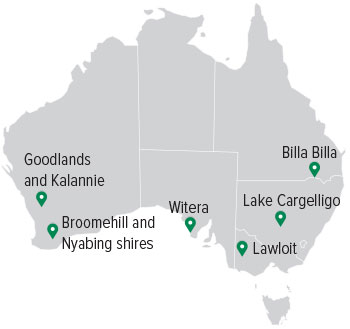
Every year, GroundCover™ tracks a group of growers throughout Australia as they navigate the cropping season. Our participants for 2025 detail their enterprises and management strategies in the first part of this year’s series
Western Australia
Jo Ashworth farms with husband Wal, son Morgan and daughter-in-law Libby at Goodlands and Kalannie, 300 kilometres north-east of Perth, WA. Wheat dominates the rotation, with oats sown for feed, hay or seed, depending on the season. The area planted to canola and lupins varies depending on rainfall. They also run a 1000-ewe Merino flock and 20 beef cattle.
Average annual rainfall: 250 to 300 millimetres, but often less than 200mm.
Professional advice: We use Reece Duffield at MarketAg and Lucy Anderton from myFARMSMART®.
Memberships: Liebe Group, CBH Growers Advisory Council, Grain Growers Australia.
Key changes: Succession is always at the forefront of our minds. We all work on the farm and have skin in the game, which impacts decision-making, like buying another farm in 2024.
The most significant change has been the installation of two mobile towers in our area four years ago. It got me into the paddock, increasing business efficiency. Connectivity in the paddock helped enormously, allowing for on-the-go decision-making and on-farm communication. We have moved from segregated roles with communication time lags to being more cohesive, where we are all included and have influence over the farm’s daily running and more extensive strategic plans.
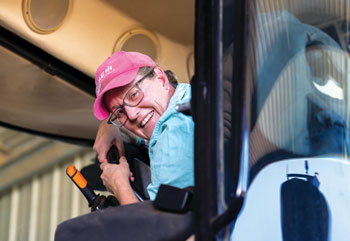 Jo Ashworth farms at Goodlands and Kalannie in WA. Photo: Evan Collis
Jo Ashworth farms at Goodlands and Kalannie in WA. Photo: Evan Collis
Goals for 2025: Moving toward more aggressive agronomic decisions is a goal. That includes increasing the liming/gypsum area. We are seeing positive results still from high rates of both – at two tonnes of each.
We are investing in newer herbicide technology for weed control and committing to higher nitrogen applications.
Challenges and opportunities: We are all working on the farm and rarely employ additional staff, so if Wal and I decide to travel, we will lose two of our operators.
R&D wish list: We need a better falling number test that is repeatable and can be calibrated. We also need an evidence-based understanding of how wheat quality changes in storage so that growers benefit financially if there is any improvement in those numbers, not only the buyers.
I’d like to see high-yielding wheat varieties – even if they are feed wheat – and more varieties resistant to pests and diseases and tolerant to drought.
Western Australia
Michael Altus farms in the Broomehill and Nyabing shires of south-west WA with wife Amanda, baby daughter Amelia and parents David and Chris Altus. The family grows canola, wheat, barley, lupin, oats for hay and vetch. The family also runs 3100 Merino ewes.
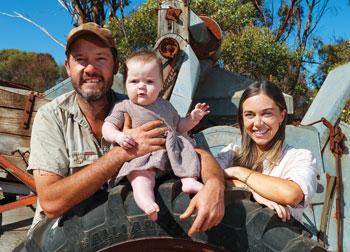 Amanda and Michael Altus with six-month-old Amelia on their Broomhill, WA property. Photo: Evan Collis
Amanda and Michael Altus with six-month-old Amelia on their Broomhill, WA property. Photo: Evan Collis
Soil pH (calcium chloride): 4.8 to 7.
Typical crop sequence: Varies with soil type. It can be a barley/canola/barley on some paddocks. On others, it can be canola/wheat/barley/pasture or barley/lupin.
Average annual rainfall: 420mm and 380mm across the two shires.
Professional support: Farmanco agronomist Mark Lawerence, Agvise farm consultant Nic Mathwin, Grain Brokers’ Lach Murphy, and RSM Accountant Marie Van Bloomstein.
Memberships: Synergy Consulting, Broomehill Cropping Group, Agworld, Figured, and Xero.
Key changes: We have recently updated our seeding bar, opting for a precision seeder. We want to ensure the seed is separated from the fertiliser to make fertiliser toxicity less of an issue. Knowing we have good separation allows us to be more flexible with rates and products.
We have started sowing earlier – by 1 April – and have increased sowing rates. Weather patterns have changed and we are relying less on traditional winter breaks and more on storm disturbances. Sowing earlier means we have more chance to catch that moisture.
We purchased a Plozza plough and have achieved excellent results ameliorating our non-wetting soils.
It is a gradual process. The best results are when we ameliorate paddocks soon after rain.
Goals for 2025: An earlier seeding can create crop establishment challenge. To help manage this, we use soil wetters (with varied results), claying and Plozza ploughing, and we are tweaking sowing depth and seeding rates.
We are also closely monitoring growers using Integrated Harrington Seed Destructors. We want to consider their results for our next machinery purchases.
Challenges and opportunities: Earlier established crops can be subject to more frost risk later in the season. Low paddocks are sown to barley and/or sown later to manage this.
Early sowing and dry conditions also have ramifications for weed control. We aim to be flexible on herbicides.
Dry conditions can also mean staggered annual ryegrass germination. We crop clean paddocks first and hope to achieve weed germination on later-sown areas before seeding. We also strategically rotate chemicals.
We are spraying and swathing canola and crunching canola stubbles to improve pre-emergent herbicide-to-soil contact.
We have recently had redlegged earth mite in crops and pastures, so we will try to establish early a high plant density. We rotate chemicals and use robust rates.
We are managing nitrogen timings to limit leaching or insufficient rainfall to activate nitrogen. We are also trialling coated urea products.
R&D wish list: I would like to see more investment into training people for farm roles and agriculture in general.
South Australia
Craig and Amanda Kelsh farm with their sons Dylan and Rhys and their sons’ partners Zoey and Jessica. Together, they farm at Witera, 50km south of Streaky Bay on the west coast of Eyre Peninsula. They crop wheat, barley, lentils, canola, field peas, lupins, vetch and oats. The family also operates a transport business carting bulk commodities and livestock and runs a self-replacing Merino flock.
Average annual rainfall: 350 to 400mm.
Soil pH (calcium chloride): 6.5 to 9
Typical crop sequence: On better soils: canola/wheat/barley followed by lentils, peas, lupins or vetch. On poorer soils: wheat/barley/medic pasture or vetch.
Professional advice: We use Pinion Advisory for grain marketing and Bates Agricultural Consulting.
Key changes: Our business, Venus Plains, was established in 2019 due to succession planning. We disbanded our former company, Glendale Pastoral Co, founded in 1985 by my father and brother.
Goals for 2025: Our goals are to improve in an agronomic and business sense to produce the best possible outcome for everyone involved in the business. We host a large trial site on our property, managed by our local Nutrien branch. This is fantastic for R&D and seeing how all the latest varieties and products perform in our backyard.
Challenges and opportunities: Season 2024 was one of the most challenging in a very long time, with a dry start, a small wet period in winter, followed by an exceptionally dry spring. This had a major impact on yields and pasture growth.
R&D wish list: I would like to see funding for frost impacts. Additionally, investments aimed at enhancing the return on investment for phosphorus in calcareous soils and boosting production in those areas.
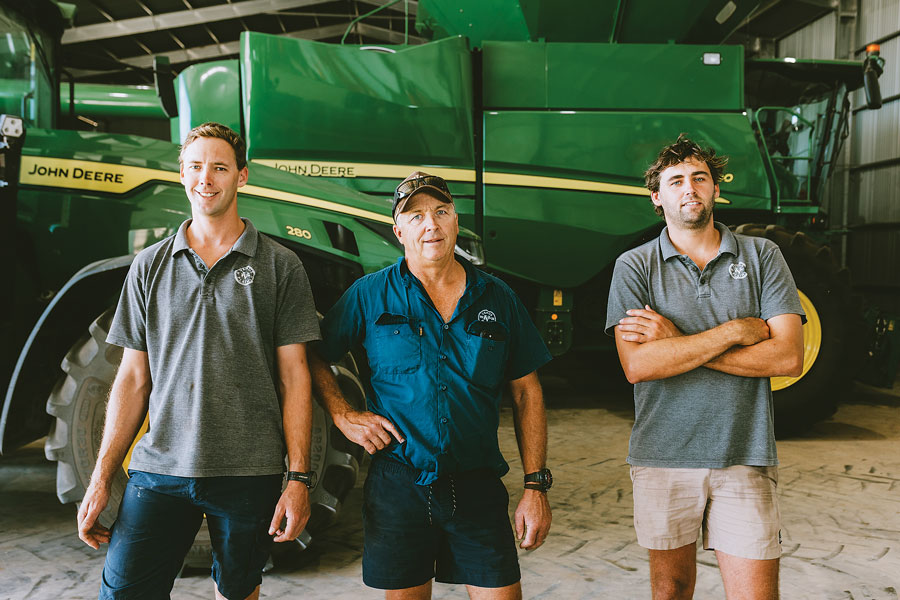
From left: Dylan, Craig and Rhys Kelsh farm at Witera on the Eyre Peninsula. Photo: Bec Smart
Victoria
John Bennett, Allison Bourchier and their children, Sophie and Hamish Bennett, run a mixed farming enterprise at Lawloit, between Nhill and Kaniva, in western Victoria. They crop wheat, barley, canola, vetch for hay, oaten hay, faba beans, lentils and field peas, and run a Merino flock. With a newer property in south-eastern Wimmera, they have a mix of soil types from self-mulching to lighter soils.
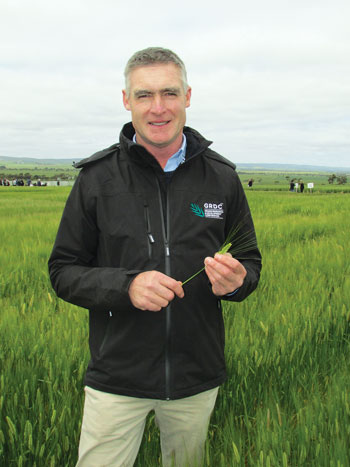 Former southern panel chair
John Bennett farms between Nhill and Kaniva. Photo: Sharon Watt
Former southern panel chair
John Bennett farms between Nhill and Kaniva. Photo: Sharon Watt
Soil pH (calcium chloride): 4.5 to 8 across paddocks and properties.
Typical crop sequence: This varies on soil types.
Average annual rainfall: Across the properties, it is 400mm to 520mm.
Professional advice: AgVantage agronomy, Market Check, People in Paddocks, AgProcue, Think Agri, ProAgtive and O’Callaghan Rural Management (now ORM).
Memberships: Birchip Cropping Group,
Farm Trade Australia.
Key changes: Soil amelioration with Dr Cassie Schefe has been a game changer for us. Cassie put together a soil testing protocol for different production zones based on NVDI and radiometric work. We undertook 1000 hectares of amelioration.
Using variable-rate maps we applied gypsum and lime. It has led to some positive results, and we have grown crops that I didn’t think possible, yielding 3.3t/ha of canola, followed by a 6.2t/ha wheat crop. It’s a fantastic result based on the capital expenditure.
We are hosting liming trials with Brian Hughes from SARDI on lighter soil in the west Wimmera where we have traditionally not been concerned about increasing acidity. Soil testing has identified this as an emerging issue for us.
Goals for 2025: To be timely in our main operations and continue to fine-tune our systems to make it easier for the people working in the business.
Challenges and opportunities: A challenge has been expanding the business while maintaining a particular standard. The larger you get, the harder it can be to achieve. The rising cost of production is also a challenge.
Carbon markets or offsets offer both challenges and opportunities. I think we will have some constraints put on us and measuring our outputs, and what we sequester will be a challenge that we need to meet.
I think autonomy and its role in agriculture is also an opportunity. I was speaking to a grower the other day who was using green on green to take out vetch in his lentils. That is the future.
R&D wish list: We need a mix of blue-sky research goals and smaller-scale research that delivers incremental results.
I tell this story a lot, but at the GRDC Update in Adelaide a few years ago I heard Professor Ross Kingwell, an agricultural economist, talk about the power of changing one per cent of your business. Projects that look at cost-effective ways to build profit are important. And disease needs to be considered just as much as yield.
New South Wales
Emma Ayliffe and her partner Craig Newham farm 4000ha across four blocks near Lake Cargelligo in central NSW. They grow wheat, mustard, canola, lupins and oats and run 1000 ewes joined to Suffolk rams for first-cross lamb production.
Average annual rainfall: 360mm.
Soil pH (calcium chloride): 5.4 to 6.7.
Typical crop sequence: Depending on the weeds’ status, the two destocked farms grow wheat/wheat/lupins or canola. The two stocked farms rotate from lucerne into wheat/wheat/lupins or canola/wheat/wheat/oats undersown with lucerne. Our rotations aim to spread risk and expenses while maximising profit.
Professional advice: Emma is an agronomist who co-owns the independent consulting business Summit Ag. With a broad network of connections, she consistently brings home innovative ideas
to explore.
Memberships: Central West Farming Systems. Before COVID-19, we initiated Tulli Young Farmers and started running small local events. Although we lost traction during the pandemic, a few of us are keen to restart that activity.
Key changes: Craig’s family is undergoing succession, so changes are coming. We started growing canola six years ago and are seeing crop management improvements. Reducing livestock numbers to focus on cropping has been a significant change. It has resulted in less tillage, so we are working out ways to handle stubble better and retain cover where possible.
Goals for 2025: We will continue working on weed control, including investing in summer residuals and suitable pre-emergent herbicides. We have issues with annual ryegrass, resistant wild oats and feathertop Rhodes grass. Jersey cudweed is an emerging problem. We will rerun our 2024 crop nutrition trials, which were wiped out by frost. The goal is to maximise our return on investment in fertiliser.
Challenges and opportunities: Timeliness is always challenging with four farms spread across 50km. We will maximise our summer moisture conservation to establish canola. If we do not have the right conditions, our challenge will be what we rotate because we need flexibility if the seasonal break arrives late.
One of our biggest challenges is maximising inputs on a tight budget. Due to plenty of rain in early 2024, we spent a lot on crops, but a severe 16 September frost reduced our profit margin. We will run a lean operation this year, but we also need to be able to capitalise on a favourable season if it occurs.
Our primary opportunity is that we have purchased another farm in an area with slightly higher rainfall. It will be great to see what we can do with that.
R&D wish list:
- Improved Jersey cudweed management.
- Further research on disease risk carryover in lower-rainfall areas to make better rotation decisions.
- Work is needed to help us manage newer canola varieties in low-rainfall areas. Some of these varieties have high flower loads in a short period, which means we must consider fungicides under certain conditions. Variety-specific management guides would be beneficial.
- More research on pulses in our local area.
- A long-term cost-benefit analysis of expensive pre-emergent herbicides in low-rainfall environments.
- Continued work on soil ameliorants.
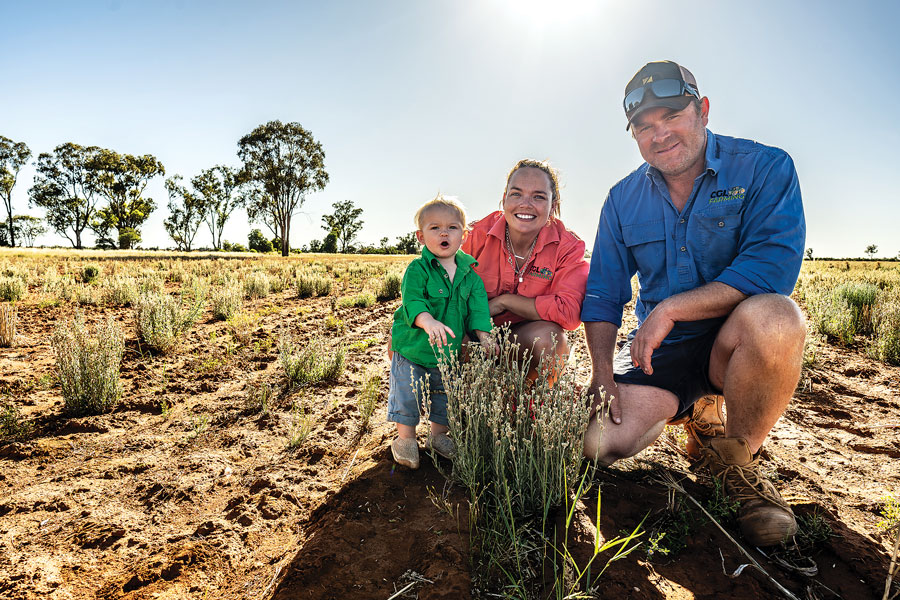
Cam Newham, Emma Ayliffe and Craig Newham with a Jersey Cudweed plant on their farm east of Lake Cargelligo in central New South Wales. Photo: Nicole Baxter
Queensland
Charlie Clark farms with his wife Jess and three young children in the Billa Billa district, north of Goondiwindi in south-western Queensland. Charlie and Jess farm irrigated cotton and wheat, dryland wheat, sorghum and chickpeas. The Lundavra National Varity Trials™ site is on the property.
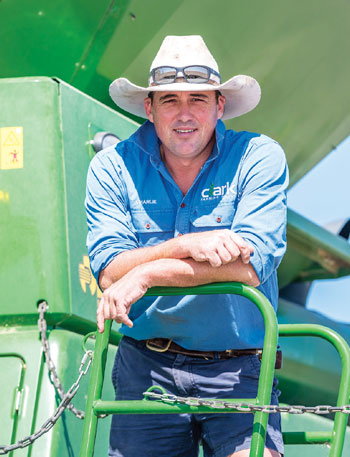 Charlie Clark farms in the Billa Billa district in Queensland. Photo: LucyRC Photography
Charlie Clark farms in the Billa Billa district in Queensland. Photo: LucyRC Photography
Average annual rainfall: 600mm.
Soil pH (calcium chloride): 8.5.
Typical crop sequence: On irrigated country, wheat follows cotton; on dryland, it is wheat/chickpeas/wheat/long fallow/sorghum/wheat. Deep phosphorous and potassium are added after the sorghum.
Professional advice: MCA Agronomy’s Stuart Thorn and Tim Richards, with mentors helping with other decisions.
Memberships: Kondinin Group, AgForce, Border Rivers Food and Fibre, Grain Growers Australia.
Key changes: We need to find the next step change in productivity gains and reduce our reliance on synthetic fertilisers and herbicides. This year, we will try a new, non-traditional weed control method. We have had a 3m SwarmBot, which tows a 24m Hayes optical sprayer, for about 12 months. While we have not necessarily saved in labour units yet, it has forced us to focus on processes and procedures so we can embrace further developments in the autonomy and robotics space.
Goals for 2025: Some of our long-term goals are gradually moving towards reducing our synthetic fertiliser and herbicide use.
This is also part of a focus on soil health. I wonder if we will have to meet some emission targets at some point. Like the non-chemical weed management options, trialling new practices is a small step in the right direction.
Challenges and opportunities: As an industry, we need to continually upskill people while also recognising the skills they already have. It would be good to have another system like the cotton industry’s myBMP (an initiative demonstrating improved farming practices and natural resource management) that strongly focuses on labour and training.
R&D wish list: I would like to see more R&D into long-season wheat varieties for variable rainfall.

























































